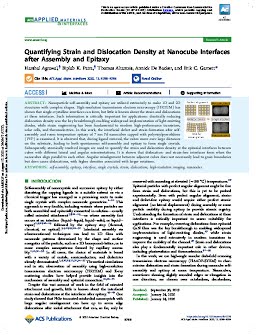2020-01-24
Quantifying Strain and Dislocation Density at Nanocube Interfaces after Assembly and Epitaxy
Publication
Publication
ACS Appl. Mater. Interfaces , Volume 12 - Issue 7 p. 8788- 8794
Nanoparticle self-assembly and epitaxy are utilized extensively to make 1D and 2D structures with complex shapes. High-resolution transmission electron microscopy (HRTEM) has shown that single-crystalline interfaces can form, but little is known about the strain and dislocations at these interfaces. Such information is critically important for applications: drastically reducing dislocation density was the key breakthrough enabling widespread implementation of light-emitting diodes, while strain engineering has been fundamental to modern high-performance transistors, solar cells, and thermoelectrics. In this work, the interfacial defect and strain formation after self-assembly and room temperature epitaxy of 7 nm Pd nanocubes capped with polyvinylpyrrolidone (PVP) is examined. It is observed that, during ligand removal, the cubes move over large distances on the substrate, leading to both spontaneous self-assembly and epitaxy to form single crystals. Subsequently, atomically resolved images are used to quantify the strain and dislocation density at the epitaxial interfaces between cubes with different lateral and angular misorientations. It is shown that dislocation- and strain-free interfaces form when the nanocubes align parallel to each other. Angular misalignment between adjacent cubes does not necessarily lead to grain boundaries but does cause dislocations, with higher densities associated with larger rotations.
| Additional Metadata | |
|---|---|
| ACS | |
| The Netherlands Organisation for Scientific Research (NWO) , European Research Council (ERC) | |
| doi.org/10.1021/acsami.9b17779 | |
| ACS Appl. Mater. Interfaces | |
| Organisation | Nanoscale Solar Cells |
|
Agrawal, H., Patra, B., Altantzis, T., De Backer, A., & Garnett, E. (2020). Quantifying Strain and Dislocation Density at Nanocube Interfaces after Assembly and Epitaxy. ACS Appl. Mater. Interfaces, 12(7), 8788–8794. doi:10.1021/acsami.9b17779 |
|
